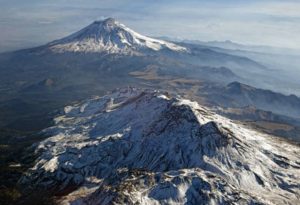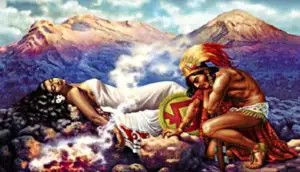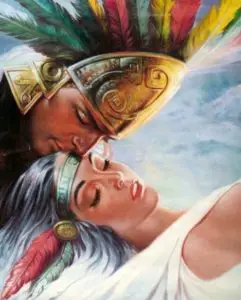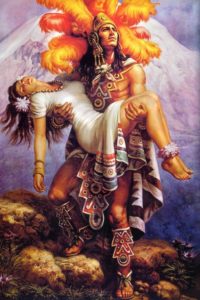Podcast: Play in new window | Download
Subscribe: Apple Podcasts | RSS
 Flying into Mexico City or arriving to the Mexican capital overland, one is instantly awestruck by two mountains to the southeast of this megalopolis. One is usually powder white and covered in snow. This mountain, a dormant volcano comprised of overlapping cones, is known as Iztaccíhuatl which means in Nahuatl, the language of the Aztecs, “White Lady.” The locals sometimes refer to the mountain by a less often used Spanish name, Mujer Dormida, or “Sleeping Woman,” and can readily point out her head, chest, knees and feet. Her partner, immediately to the south is Popocatépetl, when translated from Nahuatl means, “Smoking Mountain.” Often shortened to “Popo,” this mountain is an active volcano. In between its intermittent periods of eruption, snow fields form on its slopes, and the white-topped mountain is visible from most parts of Mexico City and from Puebla on a clear day. Iztaccíhuatl and Popocatépetl form part of what geologists call the Trans-Mexican Volcanic Belt and their peaks and ridges form part of the continental divide. The Parque Nacional Iztaccíhuatl-Popocatépetl includes almost 40,000 hectares of protected area and is home to Mexico’s Swiss-trained alpine rescue team. Some hikers and cryptid researchers also believe that these peaks are the home of the legendary Cuatlacas, a hairy creature similar to North America’s Bigfoot or the Himalayan yeti also known as the abominable snowman. For more information on the Cuatlacas, please see Mexico Unexplained episode 105. https://mexicounexplained.com//el-cuatlacas-mexican-bigfoot/ Whether this hairy hominid actually exists and lives on the slopes of these mountains may be just the stuff of legends. There are many more ancient legends connected with these majestic volcanoes, some of them possibly going back thousands of years. Following is a brief survey of the legends of Iztaccíhuatl and Popocatépetl.
Flying into Mexico City or arriving to the Mexican capital overland, one is instantly awestruck by two mountains to the southeast of this megalopolis. One is usually powder white and covered in snow. This mountain, a dormant volcano comprised of overlapping cones, is known as Iztaccíhuatl which means in Nahuatl, the language of the Aztecs, “White Lady.” The locals sometimes refer to the mountain by a less often used Spanish name, Mujer Dormida, or “Sleeping Woman,” and can readily point out her head, chest, knees and feet. Her partner, immediately to the south is Popocatépetl, when translated from Nahuatl means, “Smoking Mountain.” Often shortened to “Popo,” this mountain is an active volcano. In between its intermittent periods of eruption, snow fields form on its slopes, and the white-topped mountain is visible from most parts of Mexico City and from Puebla on a clear day. Iztaccíhuatl and Popocatépetl form part of what geologists call the Trans-Mexican Volcanic Belt and their peaks and ridges form part of the continental divide. The Parque Nacional Iztaccíhuatl-Popocatépetl includes almost 40,000 hectares of protected area and is home to Mexico’s Swiss-trained alpine rescue team. Some hikers and cryptid researchers also believe that these peaks are the home of the legendary Cuatlacas, a hairy creature similar to North America’s Bigfoot or the Himalayan yeti also known as the abominable snowman. For more information on the Cuatlacas, please see Mexico Unexplained episode 105. https://mexicounexplained.com//el-cuatlacas-mexican-bigfoot/ Whether this hairy hominid actually exists and lives on the slopes of these mountains may be just the stuff of legends. There are many more ancient legends connected with these majestic volcanoes, some of them possibly going back thousands of years. Following is a brief survey of the legends of Iztaccíhuatl and Popocatépetl.
The version of the story from the east side of the mountains involves a beautiful princess of Tlaxcala named Iztaccíhuatl. She fell in love with the most famous and most handsome warrior of her people, Popocatépetl. In turn, he fell in love with her. They were in times of war with the Aztecs, but before leaving for an important battle, Popocatépetl asked the King of the Tlaxcalans for his daughter’s hand in marriage. The father granted it to the young warrior on the condition that he return from the battle safe and sound so he could marry his daughter.
Popo went off to war, while the princess Iztaccíhuatl waited impatiently for her beloved. However, it happened that a rival of Popocatépetl who was also in love with the young woman, deceived the beautiful princess by telling her that Popo had died in the war. Faced with such news, Iztaccíhuatl’s pain was so great that the princess killed herself.
 In a surprise to everyone who heard the news of the warrior’s death, a short time later Popocatépetl returned victorious from that fight, happy because he was going to get married. When they gave him the fatal news that his fiancée had died, Popo’s world came crashing down around him. All the distraught warrior wanted was to honor the love they both had. His solution was to create a huge mountain on which to erect Izta’s tomb under the Sun. He placed the body of his beloved on top of the mountain and fell to his knees. Popo watched over his eternal love with a fiery torch in his hand.
In a surprise to everyone who heard the news of the warrior’s death, a short time later Popocatépetl returned victorious from that fight, happy because he was going to get married. When they gave him the fatal news that his fiancée had died, Popo’s world came crashing down around him. All the distraught warrior wanted was to honor the love they both had. His solution was to create a huge mountain on which to erect Izta’s tomb under the Sun. He placed the body of his beloved on top of the mountain and fell to his knees. Popo watched over his eternal love with a fiery torch in his hand.
Eventually the snow covered both bodies until two mountains formed side by side. It is said that when Popocatépetl remembers his princess Iztaccíhuatl, he trembles – either out of rage or sorrow – and his torch re-ignites. For this reason, this volcano continues to quake and emit plumes of smoke while the other remains covered in snow and forever in a state of slumber.
The story from the Valley of Mexico, the Aztec side of the mountains, is a little different. Iztaccíhuatl was the sole daughter of the emperor and empress of the Aztecs. She was very beautiful and had many suitors interested in her. She caught the eye of a warrior named Popoca who was from a noble family of a kingdom the Aztecs had conquered. The Aztec emperor thought that Popoca was beneath his daughter, so he issued a challenge to the young warrior prince. The Aztecs were expanding their empire and trying to control a rival kingdom on their southern border. They were preparing for war against that kingdom and had grand battle plans. If Popoca would come back to Tenochtitlán with the foreign king’s head, the emperor would allow him to marry Princess Iztaccíhuatl. So, the troops left for the great war and after months of being away, a soldier who was jealous of Popoca sent word back to the Aztec capital that the brave warrior had died in battle. Princess Iztaccíhuatl became so sad that she refused to eat, and after a week of moping around the royal palace, she fell ill and died. When the emperor was planning a grand state funeral for her, Popoca returned to Tenochtitlán with the victorious army. Many of the soldiers relayed stories of Popoca’s bravery and keen military strategy. The Aztec emperor offered the throne to Popoca, but  the young warrior clarified that he didn’t want to rule the Aztec Empire, he just wanted to marry Princess Iztaccíhuatl. Of course, Popoca was devastated at the loss of his love and the emperor allowed him to take the body of the princess. The warrior and his men went to the mountains and constructed a large table out of rock which would be Iztaccíhuatl’s final resting place. The gods were so touched by the scene that they turned Princess Iztaccíhuatl and the noble Popoca into great mountains so that all who saw them would remember their great devotion to each other.
the young warrior clarified that he didn’t want to rule the Aztec Empire, he just wanted to marry Princess Iztaccíhuatl. Of course, Popoca was devastated at the loss of his love and the emperor allowed him to take the body of the princess. The warrior and his men went to the mountains and constructed a large table out of rock which would be Iztaccíhuatl’s final resting place. The gods were so touched by the scene that they turned Princess Iztaccíhuatl and the noble Popoca into great mountains so that all who saw them would remember their great devotion to each other.
Another story which may date back thousands of years involves another volcano in the region, Nevado de Toluca which has the indigenous name Xinantécatl. In this telling of the legend Iztaccíhuatl and Popocatépetl were giants and they were married to each other. Another giant named Xinantécatl was in love with Iztaccíhuatl and wanted to take her away from her husband. Xinantécatl and Popo started to fight for her by throwing boulders at each other. Popocatépetl grabbed a big chunk of ice and lopped off Xinantécatl’s head, thus ending the fight. This is why Nevado de Toluca to this day has a “missing head” in the form of a flat top and is usually covered in ice and snow. Some anthropologists and folklorists believe that this story recalls violent eruptions of these volcanoes in times past. According to geologists, the last time that Nevado de Toluca erupted was 10,500 years ago, when the top of the cone of the volcano blew off the mountain. If this story really does explain the eruptions of these mountains, then this story is extremely old and may be one of the oldest legends thus identified in Mexico. If this story does go back to the time of Nevado de Toluca’s last major eruption, that means this legend has been passed down for over 500 generations.
 In addition to the traditional love story and the legend of the hairy creature called the Cuatlacas that supposedly lives on the volcanoes, Iztaccíhuatl and Popocatépetl are associated with something else that many consider to be part of the realm of folklore: the UFO phenomenon. In the latter part of the 20th Century and into the current one, people have been reporting unidentified flying craft hovering around the mountains or actually coming out of the volcanoes. Some folklore researchers and even anthropologists claim that the idea of UFOs coming out of volcanoes is related to old indigenous beliefs throughout Mexico that volcanoes serve as passageways to the underworld or portals to other dimensions. Some of these UFOS buzzing around Iztaccíhuatl and Popocatépetl have made national TV and have been seen by millions of Mexicans, so there are many who believe that these flying objects are not legendary at all. For more information about the possible UFO/volcano connection in Mexico, please see Mexico Unexplained episode number 84. https://mexicounexplained.com//mexican-volcanoes-ufos-strange-humanoids/
In addition to the traditional love story and the legend of the hairy creature called the Cuatlacas that supposedly lives on the volcanoes, Iztaccíhuatl and Popocatépetl are associated with something else that many consider to be part of the realm of folklore: the UFO phenomenon. In the latter part of the 20th Century and into the current one, people have been reporting unidentified flying craft hovering around the mountains or actually coming out of the volcanoes. Some folklore researchers and even anthropologists claim that the idea of UFOs coming out of volcanoes is related to old indigenous beliefs throughout Mexico that volcanoes serve as passageways to the underworld or portals to other dimensions. Some of these UFOS buzzing around Iztaccíhuatl and Popocatépetl have made national TV and have been seen by millions of Mexicans, so there are many who believe that these flying objects are not legendary at all. For more information about the possible UFO/volcano connection in Mexico, please see Mexico Unexplained episode number 84. https://mexicounexplained.com//mexican-volcanoes-ufos-strange-humanoids/
In popular art in Mexico and in Chicano or Mexican-American culture in the United States the colorful and often dramatic illustration of the Iztaccíhuatl and Popocatépetl legend is easily recognizable. A muscular indigenous man with a large feather headdress is carrying in his arms a beautiful but lifeless maiden. It is an image found on calendars, tattoos, t-shirts, velvet paintings and in artwork associated with the lowrider community. There are songs, children’s books and even an old movie or two to recount the legend. The imagery and the story itself harks back to a romanticized Mexican indigenous past and speak to deep-rooted feelings of love and devotion that all humans experience.
REFERENCES
Travel-Yo Website (in Spanish)
Gobierno de Mexico web site (in Spanish)
